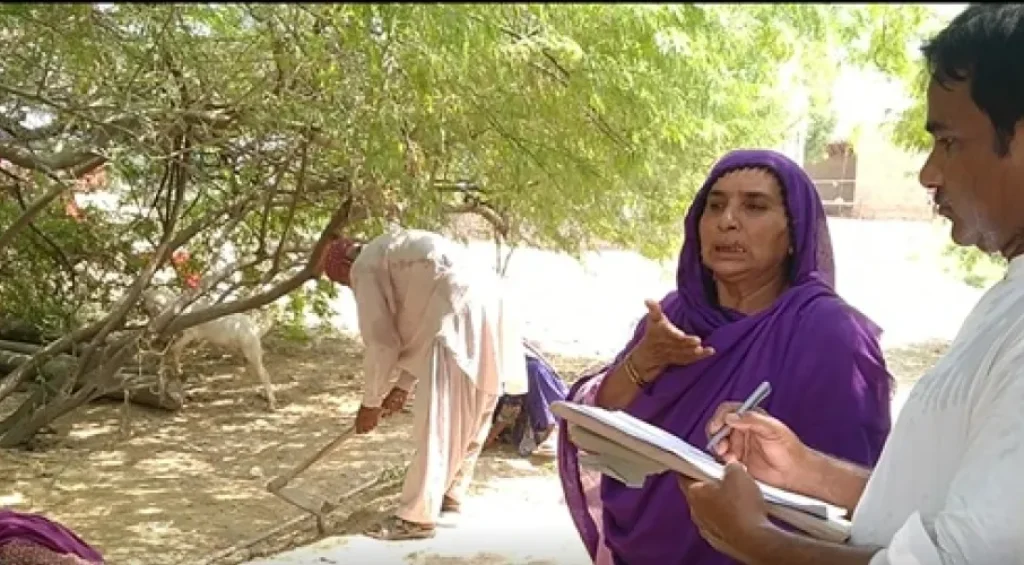A year later, the flood water has receded, but the impacts still loom large. The numbers are staggering – over 33 million people affected, 8 million displaced, 2 million homes destroyed. The floods have been described as a climate catastrophe, submerging nearly a third of the country underwater.
For many communities in Pakistan, the devastating 2022 flood was just the beginning. Inflation rose to 38 percent, plunging millions more into poverty. In fact, poverty is expected to increase from 34.2 to 39.4 percent in just one year. Food insecurity is also on the rise. Livelihoods washed away have yet to return. A challenging macroeconomic environment, a deteriorating labor market, lower remittances, and record-high food and energy prices, continue to compound the impacts of the unprecedented disaster.
In the rural village of Shaheed Benazirabad District, the flood waters destroyed roads, homes, and farms. It was there that we met Manzooran, who told us about how the village—and her children—suffered during the floods. Access to schools, markets, and hospitals was cut off for Manzooran, her children and the other residents of her village when they needed it most.
It is in this context that the Government of Sindh is rolling out a US$ 75 million community public works program, restoring damaged infrastructure while providing urgently needed income for vulnerable households. The program is a key component of the Sindh Flood Emergency Rehabilitation Project, supported by the World Bank.
The program takes a community-driven approach – residents themselves decide which roads, water facilities, or other assets to rehabilitate. Workers receive their salaries directly in their bank accounts, many of which were opened by villagers who previously did not have their accounts. Through a combination of government data and a consultative process, the poor and most vulnerable residents are prioritized to participate.
Manzooran joined 27 others, including widows and disadvantaged women and men of the district, to build an essential community access road. The program applies an approach of community-led adaptation by rehabilitating infrastructure in a climate resilient manner, utilizing local materials and knowledge. The road Manzooran rehabilitated was elevated by one meter to make it more flood-proof– strengthening its resilience as a critical access road to reach markets, schools, and basic services.

“I am so proud that the women in our village led the rehabilitation of the road. The road is higher and more resilient to flooding now. We are committed to maintaining the road through our collective efforts,” Manzooran confidently told us.
Boosting financial inclusion
On a hot humid day with temperatures reaching 42 degrees, Manzooran withdrew cash from her own bank account for the first time in her life. The participant-centric mechanism allows participants to choose the banking service of their choice for payment. The Sindh government is forging partnerships with digital service providers to enable mobile cash transfers. And importantly, for those that do not have a bank account, the program supports them in opening one.
In a country were financial inclusion remains one of the lowest in the world—at 16 percent overall and merely 11 percent for women—bank accounts can be transformational in closing the inequality gap.
With the income she earned, Manzooran purchased food for her children. For her, the program has been a lifeline.

The program aims to assist over 800,000 vulnerable households in flood-hit Sindh province – with 40 percent of participants being women like Manzooran. Widows, home-based workers, day laborers, and persons with disabilities are prioritized.
As Pakistan recovers from the floods, it’s important that programs continue to target the poorest people who were affected. To ensure that this continues, we are continuing to put communities and participants at the heart of our initiatives, and conducting an impact evaluation to provide learning for future programs. Our team is committed to supporting the most vulnerable, and helping Pakistan get back on its feet, one community at a time.
Source: worldbank



































































